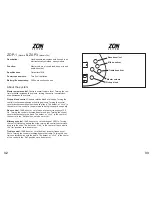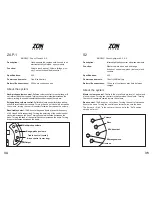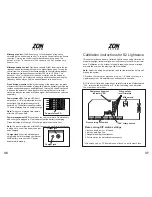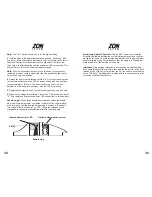
9
8
With a medium Phillips-head screwdriver, locate the screws on the pickup’s
upper treble-side corner and lower bass-side corner. Rotate these screws
counterclockwise—just enough to break them free. Next, locate the holes
at the pickup’s lower treble-side corner and upper bass-side corner.
Insert a #0 Phillips-head screwdriver into the holes, alternately rotating
the screws clockwise to lower the pickup or counterclockwise to raise
the pickup. By manipulating the screws’ height, different angles of pitch
to the pickup can be achieved, helping to fine-tune the pickup’s position-
ing and balance.
Adjusting 3-screw pickups.
Zon Sonus 4/1, 4/2, 5/1, 5/2 basses are
equipped with pickups that have three adjustment screws—two on the
bass side and one on the treble side. With a small Phillips-head screw-
driver, adjust the screws located on either edge of the pickup to achieve
the desired height. Clockwise rotation of the screw lowers the pickup.
Counterclockwise rotation raises the pickup. The machine screws used to
secure the pickups feed into threaded inserts set into the body. This pro-
vides smooth adjustment and prevents the screw from stripping the hole, a
common problem when regular wood screws are used.
About Set-Up
The amount of neck relief is a personal choice as different playing
styles require different string action. Too little relief, and the frets will
buzz. Too much relief, and the bass will be difficult to play.
General
Our composite necks
do not
require any adjustment. They are de-
signed to provide proper playing relief without the aid of a truss rod.
However, our wood necks will require periodic adjustment with seasonal
changes.
Before making a truss rod adjustment, assess the direction of adjust-
ment by sighting down the edge of the fingerboard from the string nut to
heel. Curvature of the fingerboard away from the string indicates under-
bow. Curvature toward the string indicates overbow. Ideally, the neck
should have a slight amount of underbow, just shy of being straight. If
adjusted properly, this will provide low action with minimal fret noise. For
even less fret noise and more challenging action, add relief. These
adjustments can be made with the strings at normal tension.
Important Note About Truss Rod Adjustment
Be careful
not
to overtighten the adjusting nut. Doing so could strip the
rod, making it useless. If you feel uncomfortable making these adjust-
ments, contact an experienced repairperson.
Truss Rod Adjustment
Truss rods are installed in the necks of the Mosaic and Mosaic Pro to
facilitate the correction of neck relief (overbow or underbow) caused by
string tension and/or changes in temperature and humidity. The amount
of relief in either direction directly affects the instrument’s string height
and playability.
Turn screws to adjust height
Fig. 7.
Turning each screw clockwise lowers its corner of the pickup,
while turning counterclockwise raises it.
G U I T A R S
G U I T A R S























